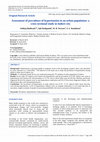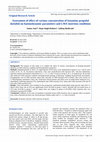Papers by Ashfaq Modiwala
International Surgery Journal, Aug 25, 2018
International Journal of Community Medicine and Public Health, May 22, 2018

International Journal Of Community Medicine And Public Health, 2018
Background: Hypertension is growing rapidly to epidemic levels in the developing countries, that’... more Background: Hypertension is growing rapidly to epidemic levels in the developing countries, that’s why described by some clinicians as a ‘silent killer’. The objective of the study was to study the prevalence of hypertension among adults in urban area of Indore city.Methods: A community based survey was conducted among the 375 residents of urban population of Indore.Results: In our study 157 subjects were found to be hypertensive with the prevalence of 41.9%. Where; new cases of hypertension were found to be with prevalence of 15.7%. Out of which males were 44 (20.3%). Whereas, previously diagnosed 98 (62.4%) subjects were on anti-hypertensive medication and 59 (37.6%) newly diagnosed subjects who did not know they were having hypertension.Conclusions: The prevalence of hypertension in study subjects was 41.9%. 15.7% subjects didn’t know that they were having hypertension. 31.6% of hypertensive subjects were on irregular medication. It was found that lack of awareness, negative atti...

International Journal of Preventive, Curative & Community Medicine, 2015
Background: India’s older population will increase dramatically over the next four decades. WHO s... more Background: India’s older population will increase dramatically over the next four decades. WHO suggested that by 2015 death from chronic diseases will increase 17% that is; from 35 million to 41 million. Ageing is mainly associated with social isolation, poverty, apparent reduction in family support, inadequate housing, impairment of cognitive functioning, mental illness, widowhood, bereavement, limited options for living arrangement and dependency towards end of life. Objectives: To study the Socio Demographic status, Medico Social problems and attitude towards life of study subjects. Methodology: A cross-sectional study carried out from March to May 2015 in Old Aged Home of Indore. A total of 79 out of 80 Elderly people of Ashram, aged 60 years and above were included. Detailed clinical history was recorded and relevant physical examination was also carried out. A detailed interview was conducted followed by medical examination. Result: Maximum study subjects were in age group of...
National journal of community medicine, 2015
Background: Food borne illness cases may occur due to improperly prepared or mishandled food, unh... more Background: Food borne illness cases may occur due to improperly prepared or mishandled food, unhygienic sanitation and cleaning practice at home by home kitchen handlers. Objective: To explore the knowledge and practice of literate female of Indore city who are dealing with Home kitchen every day. Methodology: A Cross-Sectional study among 160 participants according to their profession (Health sector workers, Non-health sector workers, House Makers and Students) were selected randomly and interviewed using self administered questionnaire. Result: It shows that the mean percentage score for the good knowledge and hygienic practice was 79.44% and 71.15%. Knowledge practice scores was significantly (p < 0.0006) different by the levels of education and for Hygienic practice a significant difference (p

International Surgery Journal, 2018
Background: The purpose of this study is to compare the effect of various concentration of ketami... more Background: The purpose of this study is to compare the effect of various concentration of ketamine-propofol (ketofol) on LMA insertion condition and hemodynamic parameters.Methods: Hundred patients of ASA I, II, aged between 18-65 years, were randomized in group A, B, C and D, each consist of 26, 25, 25, 24 patients respectively. They were premedicated with injection GPL, injection midazolam, injection fentanyl and induced with ketofol in 1:1, 1:2, 1:3 and 1:4 ratio in Group A, B, C, D respectively. 60 seconds after induction LMA insertion condition including mouth opening, swallowing, coughing, head and body movements, laryngospasm, ease of LMA insertion, apnea time, and time of LMA insertion were recorded. They were scored 1 to 3. Hemodynamic parameters- heart rate, noninvasive blood pressure and SPO2 were recorded before induction (T1), immediately following induction (T2), immediately after LMA insertion (T3), 5mins after LMA insertion (T4) and 10 mins after LMA insertion (T5)....
International Journal Of Community Medicine And Public Health, Apr 24, 2018
National journal of community medicine, 2016
ResultsMean Waist circumference (Male= 84.76, 7.646 SD; Female= 79.37, 9.343 SD) and waist hip ra... more ResultsMean Waist circumference (Male= 84.76, 7.646 SD; Female= 79.37, 9.343 SD) and waist hip ratio( male=0.880,0.055SD; Female=0.819, 0.067) were below cut off line. Calorie intake as per Indian standard was poor (Male=2098.5. 503.78SD; Female=1759.2, 362.90SD). Females were having increased risk and substantial increased risk of metabolic disorders as per waist circumference measurement (P>0.001, P>0.001). Males were more at risk as per waist hip ratio (P>0.001). At the BMI of pre-obese category, the female waist circumference was higher than cut off value (86.37 cm). Sensitivity found to be highest for waist hip ratio (28%).











Uploads
Papers by Ashfaq Modiwala